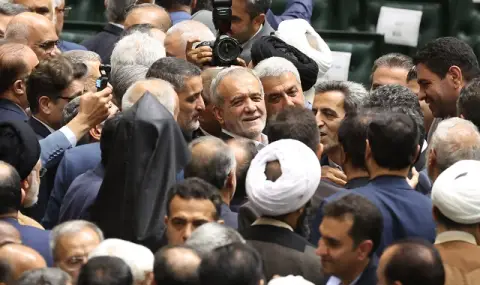Can Pezeshkian become Iran's Gorbachev? This headline of an Iranian daily has stirred spirits in Iran, writes the Saudi newspaper "Ash-Sharq al-Awsat".
The author of the article describes Pezeshkian as someone who enjoys the regime's trust, making him capable of carrying out reforms that the author did not name in order to save Iran from dangers that he also did not name. This is not the first time that informed insider sources have called for changes in the state's course.
The first to do so was Khomeini, who issued an eight-point reform manifesto that, if implemented, could have transformed Iran into a Scandinavian-style democracy without a monarchy. Needless to say, of course, that didn't happen.
Instead, the Iranian nation experienced mass executions, a war against Iraq that apparently seemed impossible to win, and corruption on a massive scale. A decade later, it was President Hashemi Rafsanjani's turn to masquerade as a champion of reform.
However, since Mikhail Gorbachev's reform program and perestroika policies had by then failed to achieve any tangible positive results, Rafsanjani referred to himself as "The General of Reconstruction", using China's de facto ruler at the time, Deng Xiaoping, as own model. The idea was: no political freedoms, but faster economic growth and income distribution.
As expected, it quickly became clear that Dunn's model would not work in Iran, as the Republic of Iran was different from the People's Republic.
In the following decade, it was Mohammed Khatami's turn to don the mantle of reform as he assumed the presidency. Khatami had greater ambitions: to right the wrongs of the European Renaissance and make Iran a role model for all mankind. But something else happened. Iran witnessed a new wave of executions and a series of assassinations and disappearances of real or imagined opponents, coinciding with worsening economic conditions.
On the other hand, his successor, Mahmoud Ahmadinejad, was wise enough to stick to Khomeini's slogans, which called for the destruction of Israel and promised to "drive out" the American "Great Satan" from the Middle East. Then it was Hassan Rouhani's turn as president to revive Gorbachev's idea by accepting the status of the Republic of Iran under the tutelage of the so-called P5+1 group led by the United States. Eight years later, he resigned, leaving Iran more isolated, poorer and more affected by corruption and violence.
For his part, Lenin was the first reformer in the Soviet Union. In 1921, he wrote in a letter to Politburo member Lev Kamenev: "We have established the dictatorship of the proletariat, but there are few workers in the party. To revive the economy, we need the cooperation of parts of the bourgeoisie." He then presented his restructuring program called the New Economic Policy. Under this policy, the party will maintain the dictatorship of the proletariat without the proletariat and allow the bourgeoisie to reform the economy. People also tend to forget that Stalin, after causing the death of tens of millions with his policy of collectivization, also tried to create his own version of Gorbachev's game. Likewise, after winning power after a seven-month struggle against hardline Stalinists, Nikita Khrushchev spent three years consolidating his position before launching a Gorbachev-style initiative at the 20th Congress of the Soviet Communist Party in 1956. He condemned the cult of Stalin's personality, but he soon realized that the Soviet regime could not exceed the permissible distance from the ideological leash.
Those who delude themselves that the ideological system can be reformed are always looking for someone who does not have a clear ideological profile and a biography open to different interpretations. It is worth noting that in 1921 Lenin was not yet known as the brutal despot he was. The true extent of his crimes only became clear in 1956. Stalin was considered the "Father of Nations" or the beloved "Uncle Joe".
Khomeini, for his part, had a meager political career consisting of two poorly written speeches and dozens of interviews conducted by itinerant correspondents in Paris. In 1981, the true nature of his regime was not as clear as it became a decade later. Likewise, Gorbachev had a poor career as a party member who rose through the ranks by standing still and doing nothing and being a nobody. When he arrived in London for a promotion to interview Margaret Thatcher, his CV contained no more than ten lines listing him as chief agricultural officer in the Central Committee, rising to head of the party and then president of the Soviet Union.
In short, Gorbachev seems like a blank face on which to paint the ideal face of the Soviet leader.
Today the newly elected president of Iran Pezeshkian shows such a blank face. In fact, his scant biography seems open to various fictional portrayals. In 1978, when the mullahs' uprising broke out, he was too young to realize what was happening. One year later the "revolution" succeeded in only four months of demonstrations during which movie theaters and cafes were burned down, mostly in Tehran—not enough time for anyone to build a revolutionary biography. In any case, Pezeshkian was in Tabriz, where there were no secret revolutionary cells fighting on the barricades or even flying the banner of Banu Hashim. Pezeshkian was one of the thousands who became revolutionaries after the success of the revolution.
Unlike his predecessors, he continued to stand on the fringes of the regime and thus remained a blank face on which a Gorbachev or Barack Obama-like face could be painted. The truth is that he has done nothing and cannot claim to be a special person, and this can also help him win the Nobel Peace Prize, as happened with Obama or even with Gorbachev.
